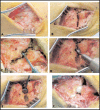The injuries to the fourth and fifth tarsometatarsal joints: A review of the surgical management by internal fixation, arthrodesis and arthroplasty
- PMID: 24353608
- PMCID: PMC3809252
- DOI: 10.12669/pjms.292.2996
The injuries to the fourth and fifth tarsometatarsal joints: A review of the surgical management by internal fixation, arthrodesis and arthroplasty
Abstract
The surgical management to the injuries of the fourth and fifth tarsometatarsal (TMT) joints is controversial. We briefly review the anatomical characteristics to the injuries, the diagnosis, as well as the individualized treatment of the injuries of the fourth and fifth TMT joints by open reduction and internal fixation, TMT arthrodesis and arthroplasty. We conclude that open reduction and internal fixation is the recommended option for acute injuries, while arthrodesis can be used in cases of malunion of the fourth and fifth TMT joints with gross pain or arthritic changes and obvious structural deformity. Arthroplasty is an effective salvage operation mainly used in high-demand patients with severe TMT arthritis. Finally, we propose a recommended treatment algorithm (based on the literature and our experience), taking into account the specific indications for internal fixation, TMT arthrodesis and arthroplasty to optimize the individualized treatment. Data sources/Study selection Data from survey reports, descriptive, cross-sectional and longitudinal studies published from 2002 to 2012 on the topic of the injuries to the fourth and fifth tarsometatarsal joint on human and radiography studies were included. Data Extraction The data was extracted from online resources of American Orthopaedic Foot & Ankle Society, American Academy of Orthopaedic Surgeons, US National Library of Medicine, The MEDLINE. Conclusion It is important to comprehend the specific anatomical characteristics and grasp the strict indications, advantages and disadvantages of the ORIF, TMT arthrodesis and arthroplasty to optimize the individualized treatment of the fourth and fifth TMT joints injuries in a maximum extent.
Keywords: Arthrodesis; Arthroplasty; Open reduction and internal fixation; Tarsometatarsal joint.
Figures




References
-
- Hatem SF. Imaging of lisfranc injury and midfoot sprain. Radiol Clin North Am. 2008;46(6):1045–1060. - PubMed
-
- Aronow MS. Treatment of the missed Lisfranc injury. Foot Ankle Clin. 2006;11(1):127–142. - PubMed
-
- Hu SJ, Yu GR, Yang YF, Wang MX, Huang SP. Ranges of motion of the fourth and fifth tarsometatarsal joints and their clinical significance: an experimental study. Chin J Orthop Trauma. 2008;10:1149–1152.
-
- Coetzee JC. Making sense of Lisfranc injuries. Foot Ankle Clin. 2008;13(4):695–704. - PubMed
-
- Dudko S, Kusz D, Pierzchaa A. Lisfranc injury—fixation with Kirschner wires. Foot Ankle Surg. 2004;10:5–8.
Publication types
LinkOut - more resources
Full Text Sources
